Requirements for the formatting of academic texts. презентация
Requirements for the formatting of academic texts. презентация
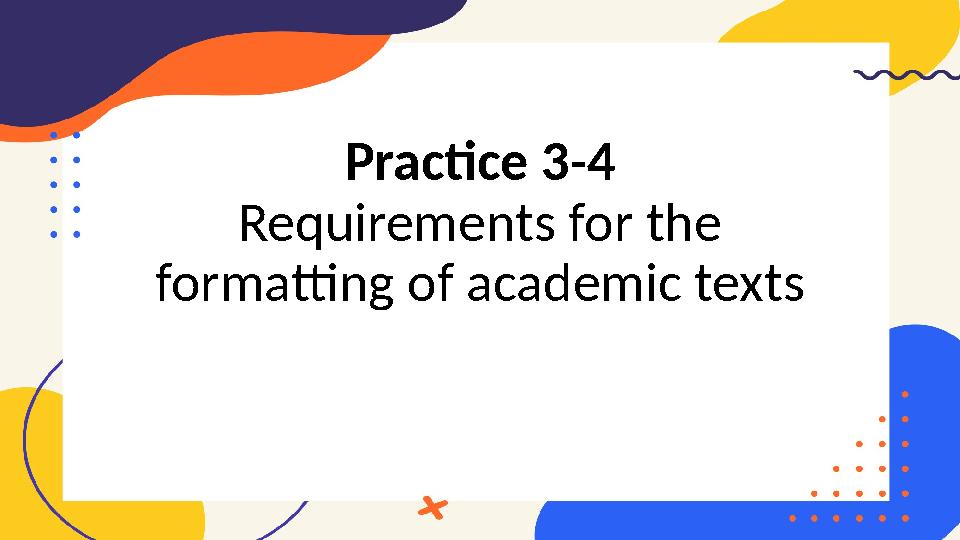

#1 слайд
Practice 3-4
Requirements for the
formatting of academic texts
1 слайд
Practice 3-4 Requirements for the formatting of academic texts
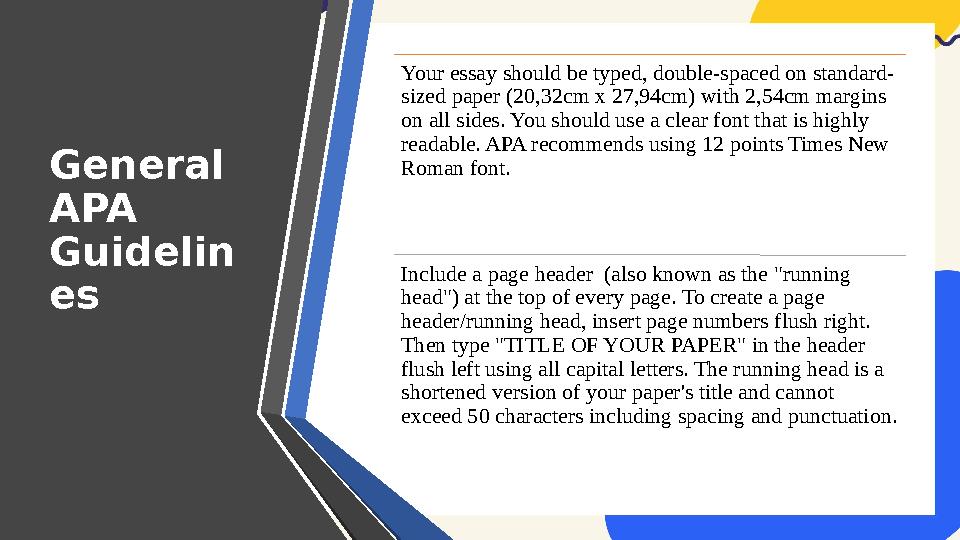
#2 слайд
General
APA
Guidelin
es
Your essay should be typed, double-spaced on standard-
sized paper (20,32cm x 27,94cm) with 2,54cm margins
on all sides. You should use a clear font that is highly
readable. APA recommends using 12 points Times New
Roman font.
Include a page header (also known as the "running
head") at the top of every page. To create a page
header/running head, insert page numbers flush right.
Then type "TITLE OF YOUR PAPER" in the header
flush left using all capital letters. The running head is a
shortened version of your paper's title and cannot
exceed 50 characters including spacing and punctuation.
2 слайд
General APA Guidelin es Your essay should be typed, double-spaced on standard- sized paper (20,32cm x 27,94cm) with 2,54cm margins on all sides. You should use a clear font that is highly readable. APA recommends using 12 points Times New Roman font. Include a page header (also known as the "running head") at the top of every page. To create a page header/running head, insert page numbers flush right. Then type "TITLE OF YOUR PAPER" in the header flush left using all capital letters. The running head is a shortened version of your paper's title and cannot exceed 50 characters including spacing and punctuation.
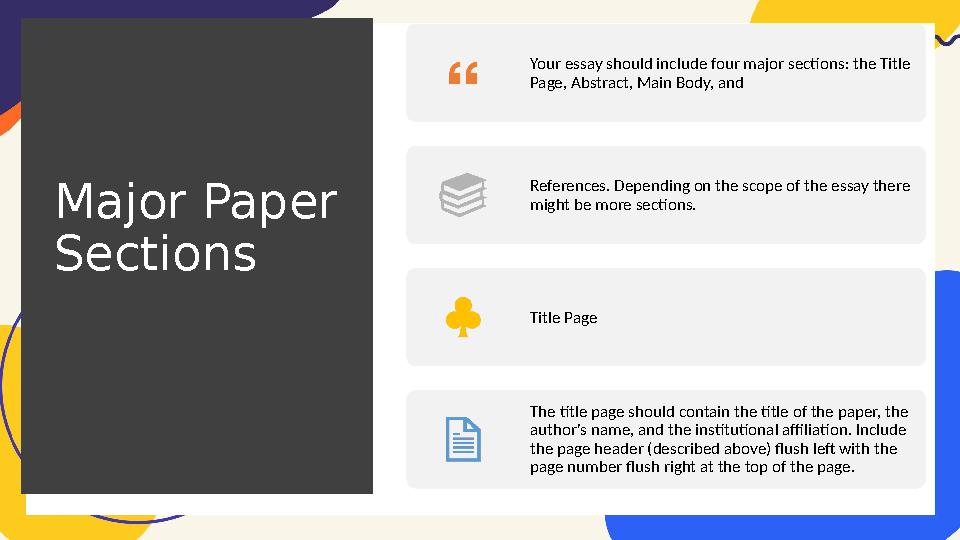
#3 слайд
Major Paper
Sections
Your essay should include four major sections: the Title
Page, Abstract, Main Body, and
References. Depending on the scope of the essay there
might be more sections.
Title Page
The title page should contain the title of the paper, the
author's name, and the institutional affiliation. Include
the page header (described above) flush left with the
page number flush right at the top of the page.
3 слайд
Major Paper Sections Your essay should include four major sections: the Title Page, Abstract, Main Body, and References. Depending on the scope of the essay there might be more sections. Title Page The title page should contain the title of the paper, the author's name, and the institutional affiliation. Include the page header (described above) flush left with the page number flush right at the top of the page.
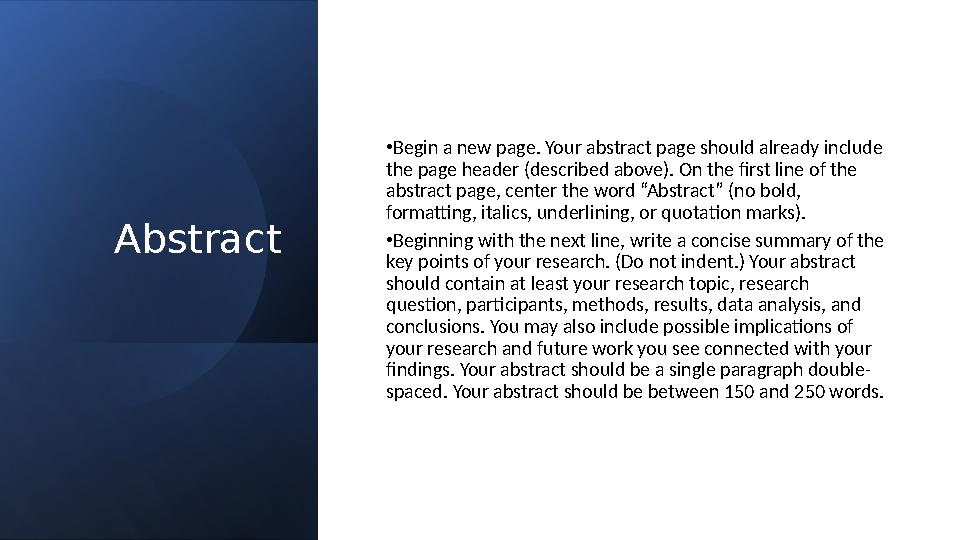
#4 слайд
Abstract
•Begin a new page. Your abstract page should already include
the page header (described above). On the first line of the
abstract page, center the word “Abstract” (no bold,
formatting, italics, underlining, or quotation marks).
•Beginning with the next line, write a concise summary of the
key points of your research. (Do not indent.) Your abstract
should contain at least your research topic, research
question, participants, methods, results, data analysis, and
conclusions. You may also include possible implications of
your research and future work you see connected with your
findings. Your abstract should be a single paragraph double-
spaced. Your abstract should be between 150 and 250 words.
4 слайд
Abstract •Begin a new page. Your abstract page should already include the page header (described above). On the first line of the abstract page, center the word “Abstract” (no bold, formatting, italics, underlining, or quotation marks). •Beginning with the next line, write a concise summary of the key points of your research. (Do not indent.) Your abstract should contain at least your research topic, research question, participants, methods, results, data analysis, and conclusions. You may also include possible implications of your research and future work you see connected with your findings. Your abstract should be a single paragraph double- spaced. Your abstract should be between 150 and 250 words.
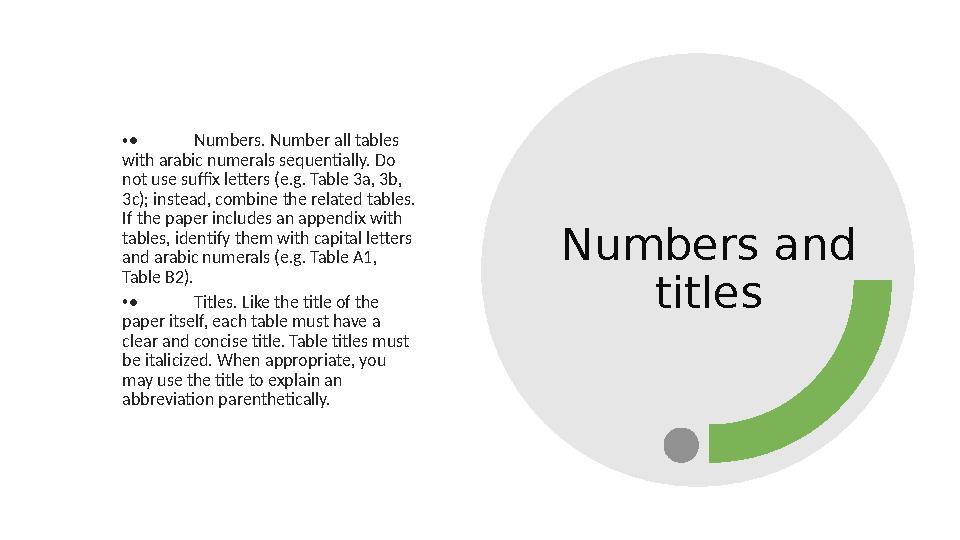
#5 слайд
Numbers and
titles
•• Numbers. Number all tables
with arabic numerals sequentially. Do
not use suffix letters (e.g. Table 3a, 3b,
3c); instead, combine the related tables.
If the paper includes an appendix with
tables, identify them with capital letters
and arabic numerals (e.g. Table A1,
Table B2).
•• Titles. Like the title of the
paper itself, each table must have a
clear and concise title. Table titles must
be italicized. When appropriate, you
may use the title to explain an
abbreviation parenthetically.
5 слайд
Numbers and titles •• Numbers. Number all tables with arabic numerals sequentially. Do not use suffix letters (e.g. Table 3a, 3b, 3c); instead, combine the related tables. If the paper includes an appendix with tables, identify them with capital letters and arabic numerals (e.g. Table A1, Table B2). •• Titles. Like the title of the paper itself, each table must have a clear and concise title. Table titles must be italicized. When appropriate, you may use the title to explain an abbreviation parenthetically.

#6 слайд
Headings and body
• Headings. Keep headings clear
and brief. The heading should not be
much wider than the widest entry in the
column. Use of standard abbreviations
can aid in achieving that goal. All
columns must have headings, even the
stub column (see example structure),
which customarily lists the major
independent variables.
• Body. In reporting the data,
consistency is key: Numerals should be
expressed to a consistent number of
decimal places that is determined by the
precision of measurement. Never change
the unit of measurement or the number
of decimal places in the same column.
6 слайд
Headings and body • Headings. Keep headings clear and brief. The heading should not be much wider than the widest entry in the column. Use of standard abbreviations can aid in achieving that goal. All columns must have headings, even the stub column (see example structure), which customarily lists the major independent variables. • Body. In reporting the data, consistency is key: Numerals should be expressed to a consistent number of decimal places that is determined by the precision of measurement. Never change the unit of measurement or the number of decimal places in the same column.
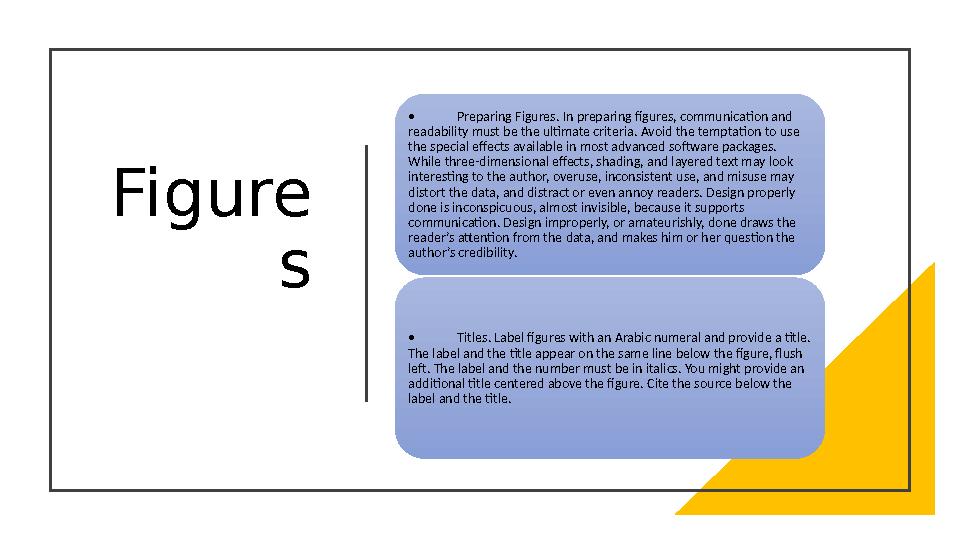
#7 слайд
Figure
s
• Preparing Figures. In preparing figures, communication and
readability must be the ultimate criteria. Avoid the temptation to use
the special effects available in most advanced software packages.
While three-dimensional effects, shading, and layered text may look
interesting to the author, overuse, inconsistent use, and misuse may
distort the data, and distract or even annoy readers. Design properly
done is inconspicuous, almost invisible, because it supports
communication. Design improperly, or amateurishly, done draws the
reader’s attention from the data, and makes him or her question the
author’s credibility.
• Titles. Label figures with an Arabic numeral and provide a title.
The label and the title appear on the same line below the figure, flush
left. The label and the number must be in italics. You might provide an
additional title centered above the figure. Cite the source below the
label and the title.
7 слайд
Figure s • Preparing Figures. In preparing figures, communication and readability must be the ultimate criteria. Avoid the temptation to use the special effects available in most advanced software packages. While three-dimensional effects, shading, and layered text may look interesting to the author, overuse, inconsistent use, and misuse may distort the data, and distract or even annoy readers. Design properly done is inconspicuous, almost invisible, because it supports communication. Design improperly, or amateurishly, done draws the reader’s attention from the data, and makes him or her question the author’s credibility. • Titles. Label figures with an Arabic numeral and provide a title. The label and the title appear on the same line below the figure, flush left. The label and the number must be in italics. You might provide an additional title centered above the figure. Cite the source below the label and the title.

#8 слайд
Citing an Author or
Authors
•A Work by Two Authors: Name both authors in the signal phrase or in the
parentheses each time you cite the work. Use the word "and" between the
authors' names within the text and use the ampersand in the parentheses.
•A Work by Three to Five Authors: List all the authors in the signal phrase
or in parentheses the first time you cite the source.
•Unknown Author: If the work does not have an author, cite the source by
its title in the signal phrase or use the first word or two in the parentheses.
Titles of books and reports are italicized or underlined; titles of articles,
chapters, and web pages are in quotation marks.
•Note: In the rare case the "Anonymous" is used for the author, treat it as
the author's name (Anonymous, 2001). In the reference list, use the name
Anonymous as the author.
8 слайд
Citing an Author or Authors •A Work by Two Authors: Name both authors in the signal phrase or in the parentheses each time you cite the work. Use the word "and" between the authors' names within the text and use the ampersand in the parentheses. •A Work by Three to Five Authors: List all the authors in the signal phrase or in parentheses the first time you cite the source. •Unknown Author: If the work does not have an author, cite the source by its title in the signal phrase or use the first word or two in the parentheses. Titles of books and reports are italicized or underlined; titles of articles, chapters, and web pages are in quotation marks. •Note: In the rare case the "Anonymous" is used for the author, treat it as the author's name (Anonymous, 2001). In the reference list, use the name Anonymous as the author.

#9 слайд
Basic
Rules of
the
Referen
ce List
•All lines after the first line of each entry in your reference list
should be indented 1,27cm from the left margin. This is called
hanging indentation.
•Authors' names are inverted (last name first); give the last
name and initials for all authors of a particular work for up to
and including seven authors. If the work has more than seven
authors, list the first six authors and then use ellipses after
the sixth author's name. After the ellipses, list the last
author's name of the work.
•Reference list entries should be alphabetized by the last
name of the first author of each work.
•If you have more than one article by the same author, single-
author references or multiple- author references with the
exact same authors in the exact same order are listed in order
by the year of publication, starting with the earliest.
9 слайд
Basic Rules of the Referen ce List •All lines after the first line of each entry in your reference list should be indented 1,27cm from the left margin. This is called hanging indentation. •Authors' names are inverted (last name first); give the last name and initials for all authors of a particular work for up to and including seven authors. If the work has more than seven authors, list the first six authors and then use ellipses after the sixth author's name. After the ellipses, list the last author's name of the work. •Reference list entries should be alphabetized by the last name of the first author of each work. •If you have more than one article by the same author, single- author references or multiple- author references with the exact same authors in the exact same order are listed in order by the year of publication, starting with the earliest.

шағым қалдыра аласыз
















